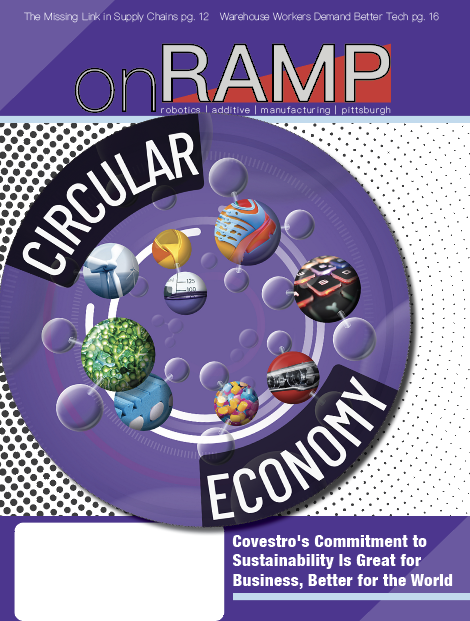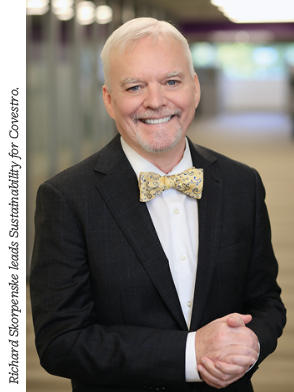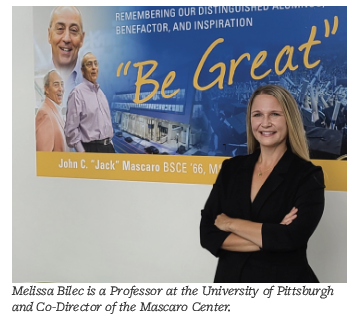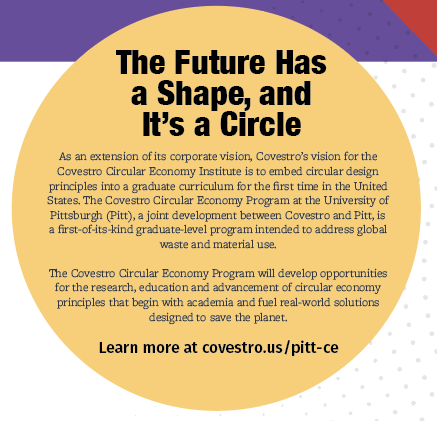Covestro's Commitment to a Circular Economy
By Tim Hayes, Contributing Writer
 You make it or buy it, you use it, and you throw it away when you’re finished with it.
You make it or buy it, you use it, and you throw it away when you’re finished with it.
That’s been the pattern of consumers – whether personal or industrial, whether large-scale or small – for as long as anyone can remember, right? But amid all that remembering, what did we forget? Oh, not much. Just the future of life on this planet.
The hard truth? The current system of take-make-waste is unsustainable. The manifestation of this truth becomes more apparent every day, with plastic in our oceans threatening marine life, climate change and the disruptive weather patterns it spawns, migrations of people and the resulting economic disparities and social issues.
What is the path out of this existential buzzsaw? A simple circle.
More companies continue to invest time and resources into their sustainability programs. Pittsburgh-based Covestro stands firmly in that category, going even further, pledging publicly to become operationally climate neutral by 2035. That translates into a host of specific initiatives, all driven by a focus on operating according to the principles of environmental protection and a circular economy – one where products are used and reused as often and as fully as possible.
“We are making increasingly specific evolutions in our sustainability journey,” said Richard Skorpenske, who leads Sustainability for Covestro.
The company believes climate change requires a commitment it can’t shy away from, pledging to tackle it with commitment and conviction. Covestro’s program fosters sustainability and is making changes to ensure that its plastics manufacturing becomes fully circular. Major milestones already have been reached, including a target of reducing specific greenhouse gas emissions by 50% per ton earlier than the projected completion date of 2025. Covestro had cut specific emissions by 54% already by 2021, compared to base year 2005. With this momentum behind it, the company set a goal to reduce absolute emissions year by year and achieve a reduction of 60% by 2030.
 Using the United Nations Sustainability Development Goals as a starting baseline, Covestro set its own initial sustainability targets, realizing it would be a gradual build to address each one. A central challenge came in aggressively pushing for meaningful sustainability performance while never losing sight of its obligation to generate profits and grow the business overall.
Using the United Nations Sustainability Development Goals as a starting baseline, Covestro set its own initial sustainability targets, realizing it would be a gradual build to address each one. A central challenge came in aggressively pushing for meaningful sustainability performance while never losing sight of its obligation to generate profits and grow the business overall.
The long-range objective includes using 100% renewable energy sources and 100% alternative raw materials. To exploit the full potential in this groundbreaking industry shift, the company continues to implement a huge internal transformation to have an optimal set-up and processes, supported by an advanced digitalization strategy and special attention devoted to embedding a company culture rooted in sustainability and circularity.
Toward that end, initial emissions reduction goals were tied to employee bonuses, said Skorpenske. But the true measure of the Covestro plan begins at the top, with Chief Executive Officer Dr. Markus Steilemann, who has stated, “We aim to be the first company in our industry to achieve operational climate neutrality.” Quite a bold declaration, which means success is imperative. Pervasive employee training and education are meant to change beliefs and behaviors. Tactical nuts-and-bolts changes in equipment and operations are meant to make the needed transitions practical, possible and cost-effective.
Other interested parties keep a watchful eye, as well. Institutional investors are increasingly looking at sustainability performance, while suppliers and customers must collaborate and comply with manufacturers’ sustainability practices to an increasing degree.
“Our goal is for one hundred percent of our supplier base to adhere to our sustainability goals,” Skorpenske explained. “They provide critical feedstocks for our products, and we all see that this is where the market is going.”
- He added that success in circularity for Covestro includes:
- Eliminating a reliance on fossil fuels
- Eliminating waste materials going into the environment
- Linking the company’s ambitions to the Paris Agreement to limit global warming to 1.5 degrees Celsius
- Developing and promoting advanced recycling technologies
- Using more renewable energy sources
“We have to do it with partners along the value chain, we can’t do all of this alone,” Skorpenske said. “A marquee example is a joint research agreement we have with the Mattress Recycling Council of California. A fee charged at the purchase of a mattress is used to fund improved recycling at product end-of-life. We’re working to apply Six Sigma principles to recycling, particularly of the polyurethane foam in mattresses, for which Covestro makes raw materials.”
Another partnership arrangement promises an even greater impact closer to home, with the Covestro Circular Economy Program, set to begin this fall at the University of Pittsburgh, with the goal of embedding circular design principles into a graduate curriculum for the first time in the United States. This innovative effort will address global waste and material use by creating opportunities for the research, education and advancement of circular economy principles. Ideas generated in the classroom and laboratory can then fuel real-world solutions designed to save the planet.
The goal of the partnership with Pitt is to educate the next generation of leaders about mechanisms to fundamentally shift from the “take, make, waste” linear economy to a circular economy where materials are reused and recycled. Students will learn how to mitigate these effects without sacrificing modern advancements made possible through high-tech materials. Through a three-pillar approach, the Covestro Circular Economy Program will provide the training and foundation for transformative change:
Academics: Coursework will focus on modern design and innovative solutions that achieve customer needs while simultaneously considering the complete product lifecycle.
Research: Research will focus on answering two broad questions:
1) How do we convert existing products from a linear to a circular model while ensuring the circular model is more sustainable?
2) How do we practice circular design regardless of product or service category?
Innovation: The Circular Economy Innovation program (CEI) will act as an incubator to foster, develop, advance and commercialize novel circular economy technology generated from the Covestro
Circular Economy Program.
“The Pitt program started with meeting of the minds,” Skorpenske recalled. “The Mascaro Center for Sustainable Innovation at Pitt talked about a potential partnership with Covestro. We both realized there is still a gap in creating a true circular economy. Companies continue trying to be circular using existing systems, when the ideal is to design circularity from the start of the product design process.
“We’re looking to bring in other companies to participate in the program,” he said. “We want to scale it nationally and globally. It would help more companies to begin looking at their own science through a different lens of circularity. We see that as very impactful.”
 Melissa Bilec, a Professor at Pitt, and Co-Director of the Mascaro Center there, expanded on a description of the Covestro partnership, saying, “Our program learning objectives are to enable students at the University of Pittsburgh to become experts in circular economy principles, informed by Covestro's successes in this area, and ultimately create circular, sustainable products and service solutions.
Melissa Bilec, a Professor at Pitt, and Co-Director of the Mascaro Center there, expanded on a description of the Covestro partnership, saying, “Our program learning objectives are to enable students at the University of Pittsburgh to become experts in circular economy principles, informed by Covestro's successes in this area, and ultimately create circular, sustainable products and service solutions.
“The program will embed circular design principles into the graduate curriculum through an innovative training program,” she continued. “It will embark on a novel, cohort-based training program that integrates existing campus resources with new courses focusing on circular economy design, while conducting convergent circular economy research that addresses pressing societal needs. Students will experience a diverse and inclusive training environment that builds upon and extends our networks, ultimately establishing a diverse and inclusive academic environment for our program, and preparing them for multiple career pathways with internships that strengthen students' understanding of various career opportunities.”
Three candidates are in the initial cohort, set to begin this fall, Bilec said.
So, with ambitious internal corporate sustainability goals having been set and met, even more aspirational targets still being pursued, and a groundbreaking partnership with a major university about to launch, the question bears repeating: Why is all of this effort, energy and expense so important?
 “Acting to become a more sustainable organization is a recognition of key trends in the environment,” said Covestro’s Skorpenske. “The effect of climate change has become obvious, which has led to this call to action. Population growth continues, with more people requiring more resources and materials. The world needs economic growth without severely depleting our resources or generating excessive waste.
“Acting to become a more sustainable organization is a recognition of key trends in the environment,” said Covestro’s Skorpenske. “The effect of climate change has become obvious, which has led to this call to action. Population growth continues, with more people requiring more resources and materials. The world needs economic growth without severely depleting our resources or generating excessive waste.
“We believe the process of circularity is critical to society, by minimizing waste, light-weighting vehicles to reduce fuel consumption, operating with greater energy efficiency wherever possible,” he noted. “Covestro’s products are part of that overall solution. We’re seeing our ecosystem move in this direction; other companies are moving in a similar direction. It’s a great business case, too – new technologies, new markets and more jobs.”
Who knows? This old planet may make it after all.